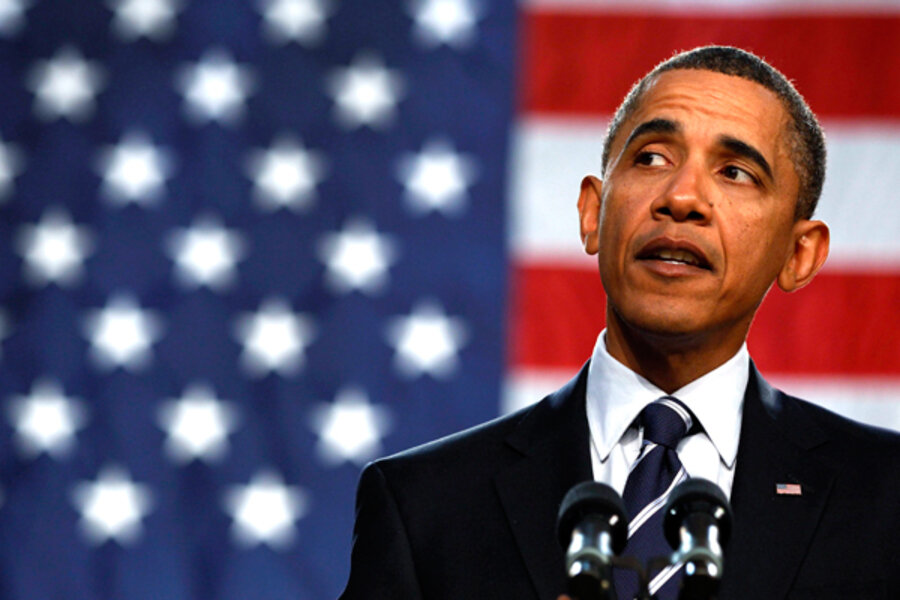Why Ohio? Behind Obama's choice of Cleveland for jobs speech
Loading...
| Cleveland
Ohio makes or breaks presidencies. That’s one reason why President Obama picked Cleveland to unveil a new plan for economic recovery just 55 days before voters decide whether Democrats keep their majorities in the House and Senate.
He’s also pointedly taking on House Republican leader John Boehner, who laid out the Republican alternative at a business forum here in Cleveland just two weeks ago. Vice President Biden has stumped in Toledo twice in as many weeks, including a speech at a Chrysler assembly plant on the administration’s investments in the auto industry and a turn with embattled Gov. Ted Strickland (D) at the Labor Day parade on Monday.
If Democrats defy the polls and beat back a GOP surge in November, it will be because voters in places like Cleveland get as fired up for Democrats in 2010 as they were in 2008. Mr. Obama picked up 60,000 new Democratic votes in Cleveland’s Cuyahoga County in 2008 and needs to energize these voters again in 2010.
As of Aug. 28, Republican turnout in primaries nationwide exceeded Democratic turnout for the first time since 1930 – and by a whopping margin of 4 million votes, according to a new study by American University’s Center for the Study of the American Electorate.
“There are some places that are fought over like one of these epic World War I trench warfare battles. It’s the Verdun of American politics,” says Ross Baker, a political scientist at Rutgers University.
But few on the streets in downtown Cleveland were aware that President Obama was speaking today. The city was beaten low by the decline of heavy industry in the 1970s and, more recently, troubles in the auto industry. While a mood of resignation persists, some small businessmen in the downtown area see a future in green tourism and gambling. Cleveland is one be the site of one of four casinos planned for Ohio, now delayed until 2013.
“I didn’t know he was coming today,” says Jonathan Sawyer, owner of the Greenhouse Tavern, the first nationally certified green restaurant in Ohio. “There are a lot of good things happening downtown,” he adds, noting that Cuyahoga Community College -- the venue for today’s Obama speech – is opening a state-of-the art culinary facility in the heart of downtown Cleveland this fall. “The downtown is coming back.”
Six House seats are seriously in play in Ohio, along with strongly contested US Senate and governor’s races now rated as tossups or trending Republican. It’s not clear whether local Democrats will embrace or run from the president’s plan – and even less clear whether Democrats or Republicans will take it up when Congress comes back in session next week.
The dueling Cleveland speeches laid down markers for congressional debate for the last weeks of Congress.
Obama on Monday proposed $50 billion in new infrastructure investment to boost the economy. Today, White House officials say that he will propose to jump-start private investment and job creation by allowing companies to fully deduct qualified capital investments through the end of 2011. He is also proposing a permanent extension of the Research and Experimentation tax credit – a measure that has been popular on both sides of the aisle.
In Cleveland on Aug. 24, Mr. Boehner focused instead on easing uncertainty about taxes and new government regulation and called on the president to announce that he will not carry out plans to impose “job-killing tax hikes” on families and small businesses.
“The White House is missing the big picture. These aren't necessarily bad proposals, but they don't address the two big problems that are hurting our economy – excessive government spending, and the uncertainty that Washington Democrats' policies, especially their massive tax hike, are creating for small businesses," he said in a statement.
In anticipation of the president’s new proposal, Boehner proposed today that both parties work together in September to promote job creation by cutting non-security discretionary spending to FY 2008 levels and to freeze all current tax rates for two years – including the 2001 and 2003 Bush tax cuts set to expire on Dec. 31.
Tuesday night, freshman Rep. John Boccieri (D) of Ohio, in a tightening reelection bid, showed up unexpectedly at a town hall meeting sponsored by his GOP challenger Jim Renacci in North Canton, at the edge of Ohio’s old industrial belt. The crowd peppered both men with questions on how they planned to revive the region’s grim economic prospects and, at the same time, rein in federal government deficits. Small businessmen complained that they could not get loans to save their businesses.
“I’m still studying the [president’s] package,” said Mr. Boccieri, who supported the first stimulus bill, as well as health care and cap-and-trade legislation unpopular in this district. But he adds that there is only so much that government can do help the economy. Interest rates are zero and tax rates the lowest that they have been since 1950, he says. “The last thing that the government has to goose the economy is to inject huge amounts of capital out there, investing in our workforce, investing in roads and bridges,” he says.
Mr. Renacci, a local businessman, said he’s fighting for less government, less taxes, more personal responsibility, and a strong military. “You don’t want to take money away from the people who create jobs in a recession,” he added.
“Ohio has a sizable number of working and middle class Americans who have been severely harmed by the recession, as well as long-term economic trends that have sent jobs overseas,” says Julian Zelizer, a congressional historian at Princeton University. “If the kind of population we find in Ohio is not convinced that the administration is helping them, Obama can see this core part of the Democratic coalition move toward the GOP.”





